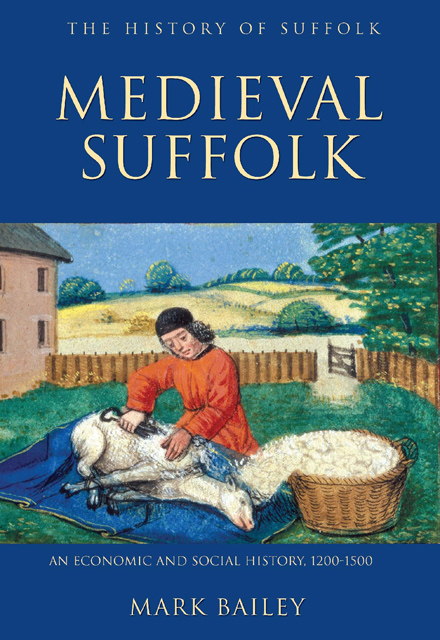Book contents
- Frontmatter
- Contents
- List of Plates
- List of Maps
- List of Tables
- Foreword
- Acknowledgements
- Note on Currency & Units of Measurement
- Abbreviations
- 1 Introduction
- 2 Landlords and their Estates, 1200–1349
- 3 Peasants and their Lifestyles, 1200–1349
- 4 The Agrarian Economy, 1200–1349
- 5 The Suffolk Landscape, 1200–1349
- 6 Towns and the Urban Environment
- 7 Commerce, Crafts and Industry
- 8 Pestilence, Rebellion and the Decline of Villeinage, 1349–1500
- 9 The Rural Economy, 1350–1500
- 10 ‘The World Turned Upside Down’: Rural Society, 1350–1500
- 11 Towns, Trade and Industry, 1350–1500
- 12 Conclusion
- Bibliography
- Index
11 - Towns, Trade and Industry, 1350–1500
Published online by Cambridge University Press: 15 March 2023
- Frontmatter
- Contents
- List of Plates
- List of Maps
- List of Tables
- Foreword
- Acknowledgements
- Note on Currency & Units of Measurement
- Abbreviations
- 1 Introduction
- 2 Landlords and their Estates, 1200–1349
- 3 Peasants and their Lifestyles, 1200–1349
- 4 The Agrarian Economy, 1200–1349
- 5 The Suffolk Landscape, 1200–1349
- 6 Towns and the Urban Environment
- 7 Commerce, Crafts and Industry
- 8 Pestilence, Rebellion and the Decline of Villeinage, 1349–1500
- 9 The Rural Economy, 1350–1500
- 10 ‘The World Turned Upside Down’: Rural Society, 1350–1500
- 11 Towns, Trade and Industry, 1350–1500
- 12 Conclusion
- Bibliography
- Index
Summary
The expansion of weekly markets and small towns in the thirteenth century had been founded primarily upon local trade in raw and processed foodstuffs, and in the provision of basic goods and services for nearby farms and households. The severe and sustained demographic contraction after the arrival of the Black Death reduced the volume of this commercial activity, and by extension reduced the volume of trade passing through fairs, weekly markets and towns. Yet the scale of this reduction was not as great as the fall in population, because consumption per head increased, and both the nature and structure of local trade changed. One major consequence of the catastrophe in 1349 was that wages rose relative to land and grain prices, reflecting the scarcity of labour, which also resulted in a rise in the disposable incomes of the lower orders of society as wages and earnings increased. These improvements in the living standards of ordinary people stimulated changes to patterns of demand, such as the swing from grain to meat (especially beef), from crude domestic utensils to professionally manufactured goods, and from basic clothing to more fashionable attire. Demand for produce made by occasional retailers and casual craft workers diminished, while demand increased for quality wares manufactured and distributed by professionals. Maryanne Kowaleski rightly argues that these changes constituted the beginnings of a consumer revolution, as ordinary people bought a larger quantity and wider range of goods and possessions. In order to meet this demand, most producers became increasingly specialist: they operated in larger units of production and kept a sharp eye on both the quality of their product and shifts in fashion. Cheap local manufactures produced by the village tailor, tanner or weaver were displaced by betterquality goods manufactured by artisans living some distance away. These new manufactures were fed through wide mercantile networks rather than peddled in rural weekly markets, and merchants concentrated upon fewer centres of trade instead of supplying a large number of local markets. Consequently, trade became less diffuse and more focused upon those sites that were well placed strategically. As Campbell states, ‘the contribution of the pre-plague period was to create an infrastructure of trade and exchange, the contribution of the post-plague era was to rationalise and reconfigure it’.
- Type
- Chapter
- Information
- Medieval SuffolkAn Economic and Social History, 1200-1500, pp. 264 - 289Publisher: Boydell & BrewerPrint publication year: 2007



